In the world of competitive online shopping, chatbots have become increasingly significant. Their acceptance rates in online retail soar to an impressive 34%, even surpassing other sectors like finance (20%) and telecommunications (25%).
Looking ahead, the outlook for chatbots in retail is even more promising. The global consumer spend via virtual assistants is predicted to reach $142 billion, up from a mere $2.8 billion in 2019. With nearly 40% of internet users across the world expressing a preference for bot interactions over virtual agents, the rise of chatbots in commerce appears unstoppable.
The benefits aren’t just customer-centric. The adoption of bots promised annual savings of $11 billion for the healthcare, banking, and shopping sectors. Additionally, around ⅔ of companies are satisfied with their implementations. And a substantial 57% of businesses report achieving significant returns on investment with minimal upfront costs.
Here’s the crucial aspect: 62% of respondents prefer interacting with a client service assistant over waiting for a human agent. Moreover, 69% of consumers express satisfaction with their most recent bot interaction.
If these statistics aren’t ringing the bells, what will? The eCommerce chatbot revolution is in full swing, and its potential to transform your business is boundless. At Master of Code, we’ve been pioneers in bot development. We invite you to explore the vast potential of solutions in retail, bolstered by our expertise.
Table of Contents
5 Ways Chatbots Transform Retail Experiences
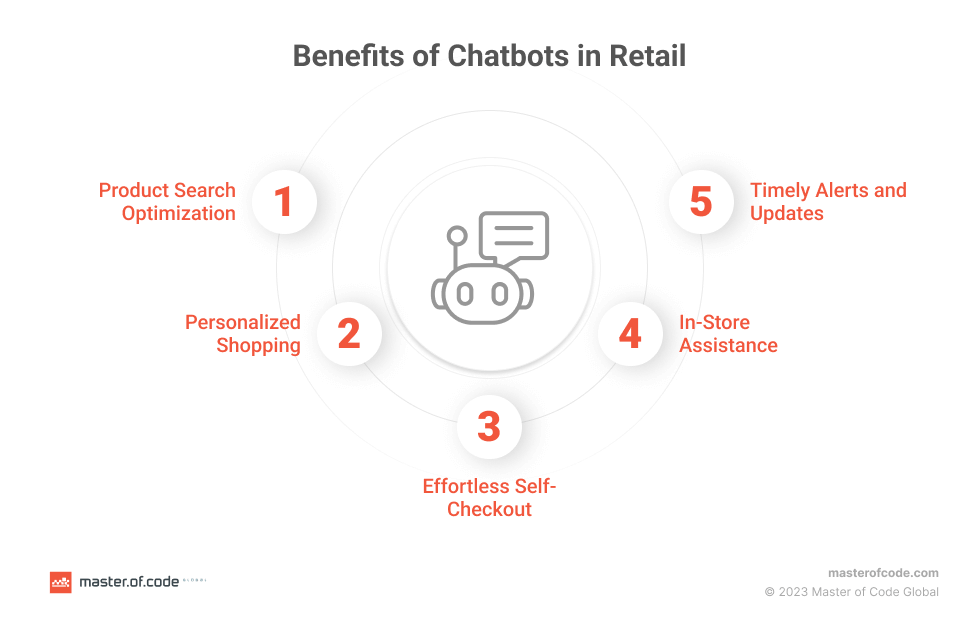
What is a chatbot in the retail industry? It is a virtual assistant that can simulate conversations with customers to answer questions, provide support, and make sales. They offer a multitude of benefits that cater to both businesses and clients. Here are five key benefits of chatbots, supported by compelling statistics:
Helping Customers Find the Perfect Product
Finding the perfect product can be overwhelming. Virtual agents act as personal shopping assistants, helping clients navigate this landscape with ease. They can instantly provide product recommendations based on consumer preferences and needs. Remarkably, 47% of consumers are open to using a chatbot to make a purchase. Furthermore, a striking 71% of surveyed Gen Zs actively seek products using bots.
Delivering a Truly Personalized Shopping Journey
Personalization is crucial across the entire customer journey. A substantial 76% of consumers prefer brands that offer personalization, and it goes beyond just driving sales. 78% are more likely to recommend personalized brands and make repeat purchases. Retail assistants excel at personalization by remembering consumer preferences and purchase history. This enables them to suggest tailored products and promotions, enhancing the overall shopping experience.
Making Checkout Fast and Frictionless
Long checkout processes can deter even the most enthusiastic shoppers. Chatbots streamline this by facilitating quick and easy self-checkout. In fact, according to a survey by the National Retail Federation, the most crucial factors when deciding where to shop are quick search (58%), quality service (44%), and speedy or simple checkout (42%). Intelligent assistants exceed in delivering these essential aspects of the shopping journey.
Turning In-Store Visits into Seamless Experiences
Navigating physical stores can be a challenge, especially during busy times. Integrated with store inventory data, bots can guide clients to the products they seek. They provide real-time information on product availability and store layouts. No surprise, they are predicted to become the primary channel for customer service in 25% of all businesses by 2027.
Keeping Customers Informed Anytime, Anywhere
Chatbots provide real-time updates 24/7. This ensures clients are informed about the status and estimated time of arrival of their orders or new offers. In fact, 64% of internet users consider 24-hour service the best feature of bots, which is especially critical in retail. Furthermore, digital agents have proven to be effective sales boosters. As evidenced by Decathlon, where 29% of conversations occurred outside of regular store opening hours.
Learn the essential steps to creating high-conversion eCommerce chatbots.
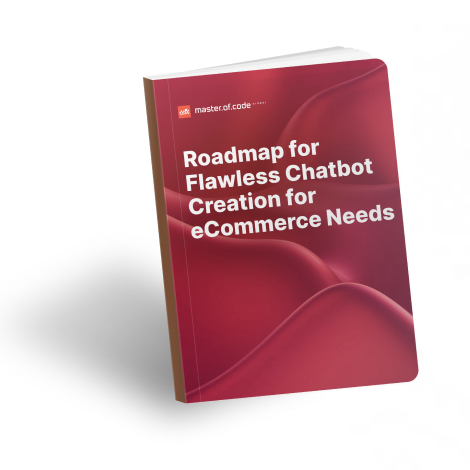
Types of Chatbots in Retail
Choosing the right type of chat-based assistant is critical to meeting key business objectives. Each category offers different strengths, from simple chatbot use cases to intelligent automation, and aligning them with your goals can significantly improve ROI.
Rule-Based Chatbots
These tools operate on pre-defined scripts and decision trees. Ideal for handling predictable, repetitive queries like store hours or return policies, they provide quick answers without complex backend functions. They’re easy to deploy: 34% of online retail customers report being comfortable interacting with such assistants.
Conversational AI-Powered Chatbots
These solutions possess advanced chatbot features like Natural Language Processing (NLP) to understand user intent and respond in a more human-like way. They adapt over time by learning from past interactions, making them ideal for product searches, upselling, and customer support.
Hybrid Chatbots
This type mixes two skills: the quick, clear answers of a rule-based bot and the smart, flexible replies of AI. For example, they can instantly tell a shopper if a shirt is in stock, then switch to giving outfit ideas according to one’s style. This way, conversations feel smooth and helpful from start to finish, often seen in some of the best chatbot examples.
AI Agents
Think of these as your next-gen virtual collaborator. They don’t just answer questions; they can complete tasks from start to finish. For example, an AI agent can help a customer order a pair of shoes, check stock in the nearest store, arrange delivery, and send a tracking link, all without any human stepping in. This makes shopping faster, easier, and more personal.
The Technology Behind Effective Retail Chatbots
Behind every great eCommerce chatbot is a set of smart technologies that make conversations faster, more accurate, and more unique.
AI
Artificial Intelligence is what gives chatbots their “brains.” It enables them to recognize patterns, learn from past interactions, and make decisions in real time. In retail, it helps them recommend products, predict what customers might want next, and even spot upsell opportunities during a chat.
NLP
Natural Language Processing is how chatbots understand and respond to human language. Instead of relying on exact keywords, NLP allows them to pick up on meaning, intent, and tone, so whether a customer types “Where’s my order?” or “I still haven’t got my package,” the bot knows they’re asking the same thing.
Personalization
Client-focused setup makes the experience feel one-to-one. By using data like purchase history, browsing habits, and preferences, chatbots can offer tailored product suggestions, timely reminders, and even special discounts. This not only improves the shopping journey but also builds trust and loyalty.
Chatbot Use Cases in Retail
From browsing to buying, such tools are transforming how retailers connect with customers. We will explore the diverse and impactful chatbot use cases in the industry, showing how they help shoppers find what they need, solve issues instantly, and even inspire new purchases.
Product Recommendations
Bots have proven to be game-changers in the retail industry, boosting sales by an impressive average of 67%. Notably, 26% of all sales originate from initial interactions. Intelligent assistants function as personalized shopping advisors, leveraging data on customers’ past purchases and preferences to offer tailored product recommendations. As clients browse, these automated agents can seamlessly suggest items they’re likely to love. This enhances the shopping experience, improves client satisfaction, and ultimately drives higher sales for brands.
Product Comparison
When a customer is shopping online and wants to compare products, a bot serves as a helpful assistant. It presents easy-to-understand tables or lists, laying out the essential features, prices, and reviews of different products. This makes it effortless for consumers to assess their options and make informed decisions. So they save valuable time that would otherwise be spent toggling between multiple browser tabs.
FAQs Around the Clock
Americans highly prioritize customer service, with 90% considering it when choosing a business. Additionally, 51% expect businesses to be accessible 24/7. Retail virtual agents, available 24/7, play a crucial role in meeting these expectations. They offer assistance, from clarifying return policies to checking product availability, ensuring clients consistently feel valued and informed round-the-clock.
Find Nearby Stores
The chatbot can help customers find the closest stores with just a few taps. It uses location data to pinpoint nearby outlets, providing addresses and contact details. So, clients can plan their visits with confidence, knowing they’re headed in the right direction.
Collect Feedback
Research reveals that over 80% of clients are eager to provide feedback about their business experiences. Moreover, 85% of small and medium-sized enterprises acknowledge the value of online customer feedback. In fact, chatbots collect questions and feedback through prompts for ratings and reviews. This feedback serves as a vital resource for businesses, enabling them to pinpoint areas for enhancement and continually refine their products and services.
Place Orders
Ordering products through a chatbot is as simple as having a conversation. Consumers chat with the self-service tool, select items from its suggestions, provide their shipping information, and confirm their purchases. It’s like shopping with a friend who takes care of all the details, ensuring a smooth and secure transaction. This user-friendly approach encourages more customers to complete their purchases.
Track Orders
Chatbots keep clients updated on their order status. They provide real-time information on shipment progress, estimated delivery times, and contact details for shipping companies. Therefore, clients can effortlessly track their orders with bots, ensuring a seamless shopping experience.
Multilingual Support
Around 40% of U.S. consumers have used a retail chatbot. However, in a country where 22% speak languages other than English at home, multilingual chatbots are essential. They allow customers to interact comfortably in their language of choice. This capability is particularly vital for businesses operating in diverse or global markets, as it significantly enhances accessibility and engagement.
Manage Complaints
Chatbots for retail efficiently handle complaints, collecting details and escalating complex problems. This ensures timely resolution, enhancing support service. They also track past complaints for issue identification and prevention.
Infer the Levels of Satisfaction
Over 90% of marketers recognize that personalization significantly boosts business profitability. Moreover, brands offering personalized shopping experiences see a 40% increase in consumer spending. Advanced AI-powered assistants equipped with natural language processing capabilities go a step further. They analyze clients’ conversations, gauging satisfaction levels by detecting positive or negative sentiment. This enables businesses to proactively address any issues to both attract new and retain satisfied customers.
AI Chatbot for Retail Client Service
Such a tool works like a 24/7 help desk. It can answer questions about orders, returns, or store policies in seconds, no waiting on hold. Because it connects to systems like inventory and shipping, the answers are always up to date. Behind the scenes, chatbot development services make this possible by creating smart, reliable tools that allow clients to get quick, accurate support while freeing teams to focus on complex cases that need a human touch.
Shopping Chatbots
It’s like having a helpful salesperson, but on your screen. They can help you find the right product, show similar items, compare prices, and even walk you through checkout, all in the same chat. By giving personal suggestions and making buying easier, they create a smoother overall shopping experience and boost conversion rates.
Retail Chatbot Examples
Across the industry, brands are finding creative ways to make shopping faster, easier, and more personal. We’ll take a closer look at some of the prominent retail bot case studies that showcase how companies using chatbots are reshaping customer interactions and boosting results.
La Mer Chatbot
A prime example of a tool for retail solutions is the one developed for luxury skincare brand La Mer to bring the in-store consultation experience online. This tool guides users through an interactive quiz to recommend personalized skincare regimens, answers product questions in a natural, chat-based flow, and provides ingredient details. It also connects to live chat for complex requests and includes a store locator for in-person visits, mirroring La Mer’s high-touch service. The solution delivered strong engagement results, with over 3,350 trained utterances and five unique features.
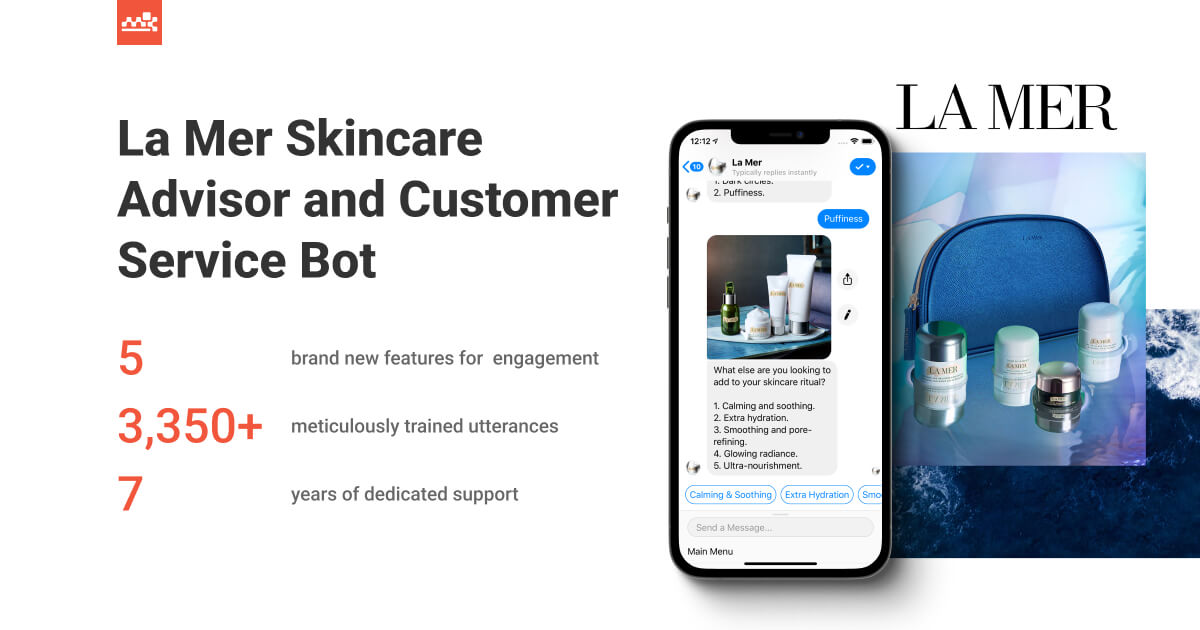
OneClickUpsell (OCU) Application
OCU is a powerful retail solution built to help Shopify merchants boost revenue through pre- and post-purchase upsells. What started as a single-store customization evolved into a multifunctional upsell engine with dynamic product offers, Artificial Intelligence-generated descriptions, and real-time split testing. In 2024, a Generative AI upgrade made the app even smarter, guiding merchants with upselling strategies, automating content, and optimizing every step of the customer journey. As one of the most innovative tools in the chatbots for retail industry ecosystem, OneClickUpsell supports over 11,000 active stores, drives 10–50% higher average order values, and has generated over $700M in upsell revenue to date.
Burberry Bot
To bring its signature luxury experience online, Burberry launched a retail AI chatbot via Facebook Messenger. This conversational concierge offered real-time style advice, personalized product suggestions, and exclusive content, from live-streamed runway shows to curated gift ideas. Customers could explore collections, receive event updates, and shop directly within the chat interface. As one of the standouts, it helped boost engagement, drive sales, and build long-term loyalty, all while staying true to Burberry’s high-touch brand experience.
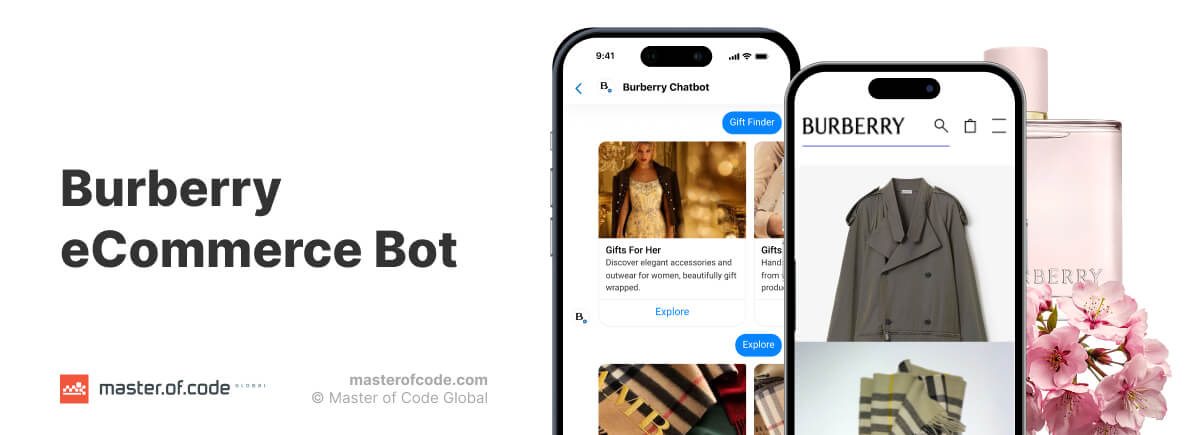
Electronics Retail Chatbot
For a global electronics manufacturing company, we built a tool that works right inside Apple Messages for Business, acting as a real-time chatbot shopping assistant for iOS users. Integrated with Shopify, the bot helps customers browse products, check out without leaving the chat, and even ask follow-up questions. Using smart technology, it understands natural language and recommends the best-fit items based on user needs. Launched just in time for Black Friday, the tool elevated engagement (84% session rate), raised average order values to $300, and achieved an 80% CSAT score, proving that smart automation can lead to real results.
Jewelry Retail Chatbot
A global luxury jewelry brand needed a way to streamline international support across time zones. The solution? An intelligent client care assistant built for Apple Messages for Business. It instantly routes clients in the UK, USA, and Canada to available human agents, based on location, language, and staffing hours. It also solved technical issues in their previous setup to ensure smooth Apple verification. As an AI chatbot for retail customer service, it helped deliver 4,600+ conversations in the U.S. within the first month, 200+ client engagements in Canada, and over 150 helpful chats in the UK, all while reducing delays and boosting satisfaction.
BloomsyBox
This floral subscription brand wanted to create a more heartfelt gift-giving experience, especially for Mother’s Day. The team launched an interactive eCommerce bot that ran a daily quiz, with winners receiving free bouquets. But this wasn’t just a fun campaign. The customer-centric chatbot also helped users generate unique, personalized greeting cards using machine-powered language tools. Messages ranged from sweet to silly, giving each winner a meaningful way to say “I love you.” The campaign saw impressive results: 60% of users who engaged completed the quiz, 28% got all answers right, and 78% of winners claimed their bouquet, showcasing how conversational technology can drive engagement and loyalty.

Zipify Pages
Zipify Pages is a high-performing page builder for Shopify that empowers merchants to create professional, conversion-focused landing pages, no coding required. With drag-and-drop tools, mobile-optimized templates, and smart content generation features, it streamlines page creation and boosts store performance. With over 100,000 active pages and 13.5 million monthly views, Zipify Pages is trusted by 15,000+ brands to improve visibility and maximize revenue.
Embeddable Voice Assistant
We built a lightweight, voice-driven system that integrates smoothly into mobile apps. Designed for quick deployment, it lets brands add natural, hands-free conversations to their platforms, no clunky interfaces or long dev cycles required. This tool goes beyond a typical AI customer service chatbot, offering voice-powered support that works across iOS and Android. It’s fast to prototype, easy to customize, and helps businesses connect with users in a more human way.
ShopJedAI Application
ShopJedAI is a smart virtual assistant built for Shopify merchants that simplifies the journey, from answering product questions to enabling in-chat purchases. Integrated into Apple Messages for Business, it aids users track orders, discover deals, and get instant support. This tool is a great example of the use cases of chatbots in retail, showing how automation can elevate user satisfaction and reduce manual tasks. With 86% accurate responses and smooth performance, ShopJedAI proves how conversational technology can drive conversions and strengthen loyalty.
AI Bot Security Audit
For a regional homeware marketplace, securing their customer-facing assistant was a top priority. As part of their broader retail chatbot development efforts, we audited their LLM-powered bot to reduce vulnerabilities, improve conversation design, and protect user data.
- +10% increase in average order value
- $80K saved by preventing data breaches
- +20% rise in positive client feedback
This case verifies that secure, user-friendly solutions aren’t just safer; they’re better for business too.
Chatbot for a Luxury Fashion Consignment Brand
To deliver white-glove service at scale, a leading luxury consignment retailer introduced a chatbot that supports both buyers and sellers. From pre-sale questions to post-purchase support, the assistant guides users through a secure, high-end experience designed to match the brand’s in-store standards.
The solution was seamlessly integrated into their checkout flow and personalized with VIP routing and smart response handling. This implementation is a prime example of how chatbots for retail can elevate client care and transaction security in the luxury space.
Results:
- 89% customer satisfaction
- 91% first-contact resolution
- 8 premium features tailored for their audience
Tom Ford Beauty Chatbot
To stand out during the holiday shopping rush, Tom Ford launched a Facebook Messenger assistant that acted as a virtual gifting concierge. Designed to guide users through tailored product suggestions, it created an engaging and interactive experience using visuals, quizzes, and smooth transitions to purchase. In just one month, the bot attracted over 8,000 users and drove 2,000+ product clicks to their online store. This is a strong illustration of how to build a chatbot for an online retail store that combines luxury with measurable results.
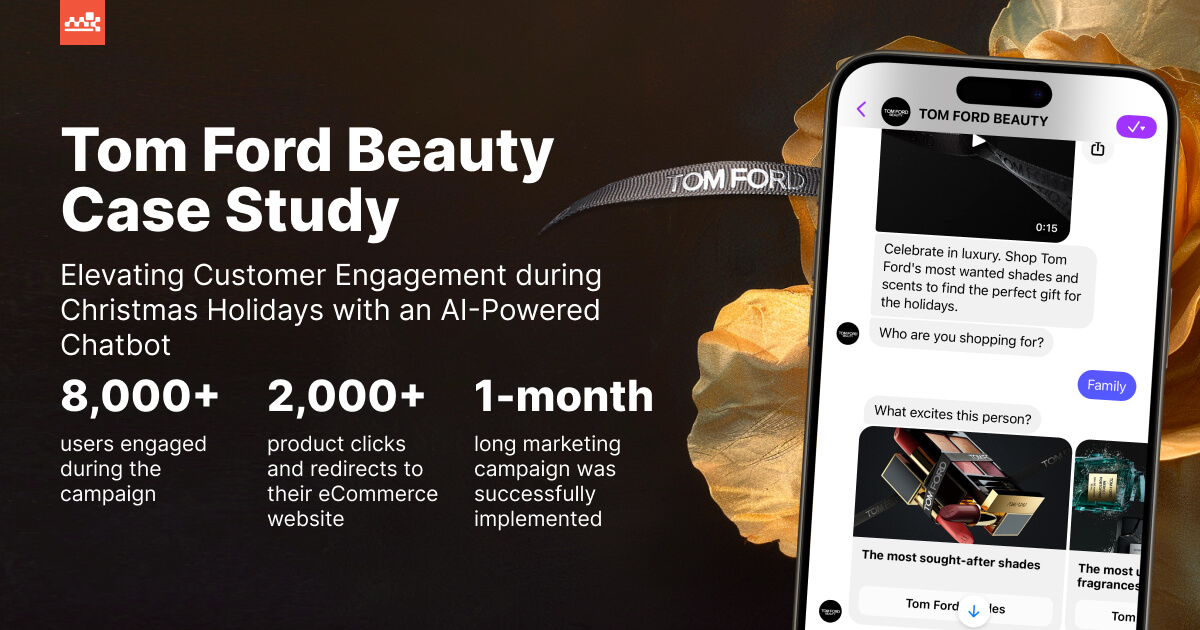
Zipify Agent Assist Chatbot
As one of the many success stories among retailers using chatbots, Zipify deployed an internal assistant that helps agents find answers quickly by analyzing past conversations and help docs. Integrated directly into Intercom, it also automates knowledge base updates, reducing repetitive work. Paired with a real-time analytics dashboard, the system tracks performance, highlights trends, and enhances response quality. The result: faster resolutions, reduced agent workload, and a better overall support experience.
American Eagle’s Facebook Chatbot
American Eagle Outfitters turned to Facebook Messenger chatbot to connect better with its customers. It was introduced during the 2016 holiday season and quickly became a valuable tool for the brand. It made it easy for consumers to reach out, resulting in millions of messages exchanged.
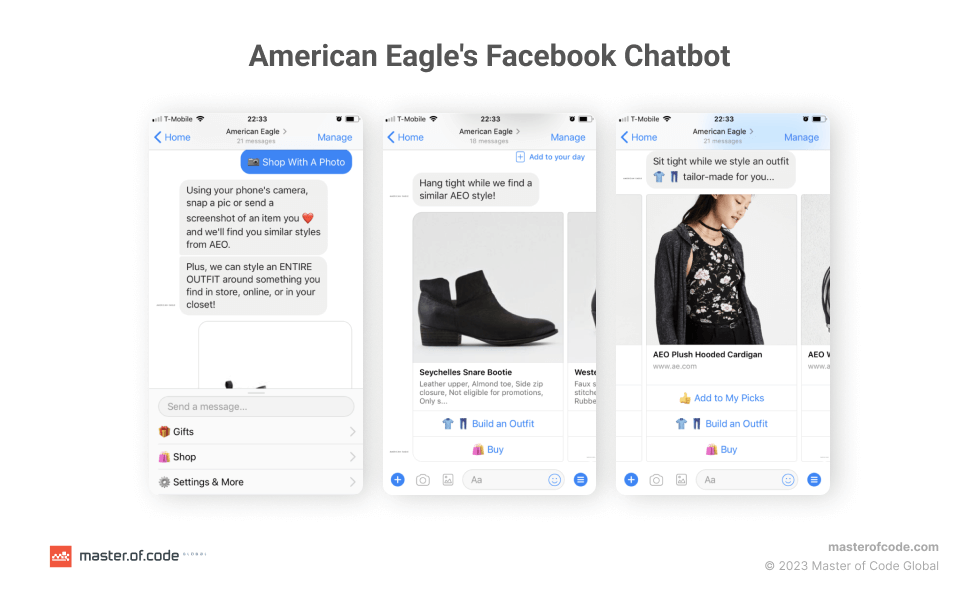
The company has also seen a remarkable 25% clickthrough rate to the website and the addition of 75% of new consumers. This innovative approach allows American Eagle Outfitters to maintain a close, one-on-one connection with its shoppers. The chatbots offer various services, including customer support, fit and care advice, branded content, and shopping assistance, enhancing the overall experience for clients.
Cheerble FAQ Chatbot
Research indicates that an astonishing 82% of clients value swift responses when reaching out to businesses for sales or marketing inquiries. What’s more, a remarkable 89% of buyers are more likely to return to a brand if they’ve enjoyed a positive service experience. FAQ chatbots emerge as a powerful solution to meet these demands.
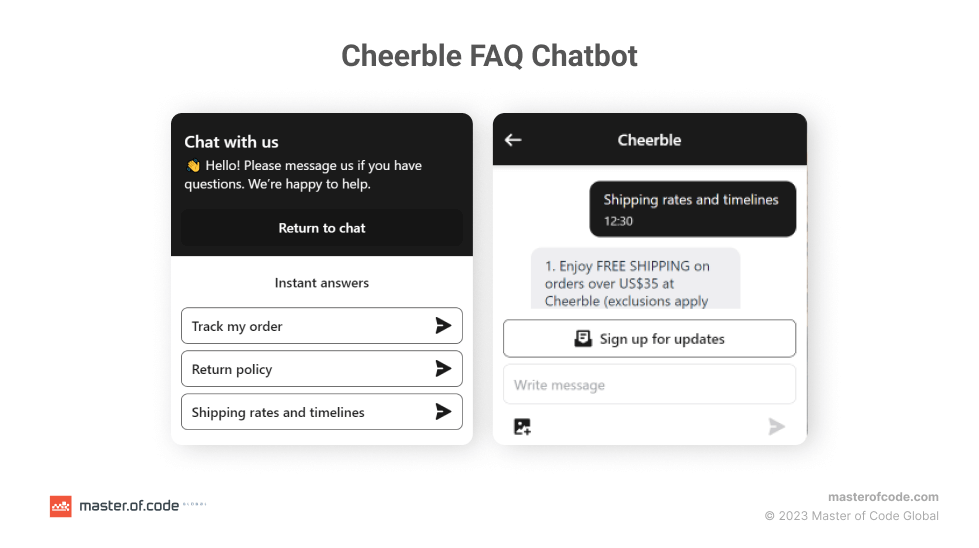
It’s no wonder that numerous companies have integrated these chatbots into their operations. Take, for instance, Cheerble, which has used the capabilities of an FAQ chatbot to turbocharge its customer service. It efficiently addresses common queries about their services, spanning from order tracking and return policies to shipping specifics. The result? An elevated customer experience that simplifies the buying process and keeps consumer delighted.
Store Assistance with Ask Sam from Walmart
Ask Sam, a voice assistant designed to assist in-store associates, streamlines tasks and boosts efficiency. By asking questions such as “Where’s the hand soap?” or “Who’s in charge of the apparel department today?” associates can access information quickly and hands-free. This innovative tool simplifies their work, ultimately enhancing service.
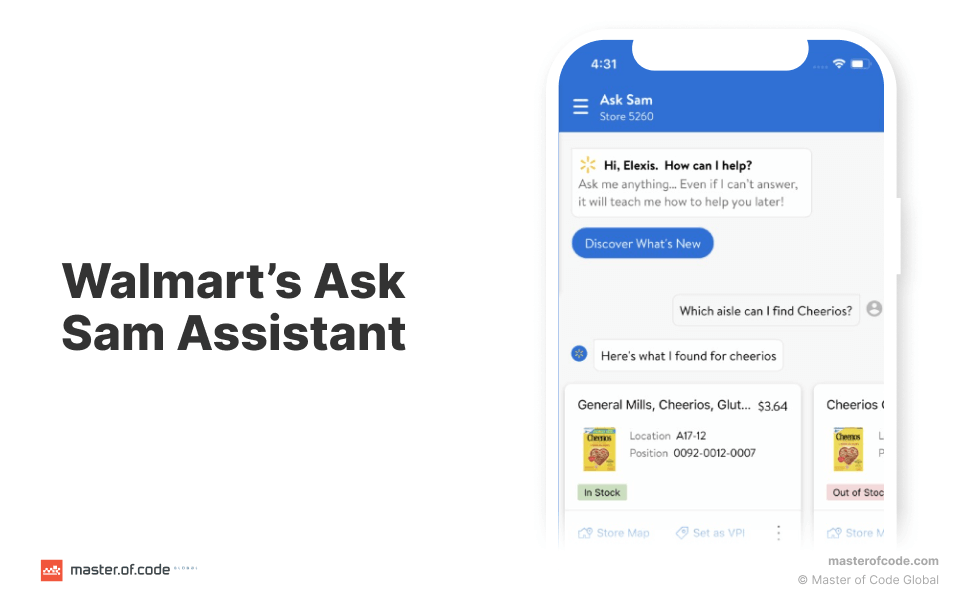
Imagine having a helpful bot by your side throughout your workday. Ask Sam offers this kind of support, making shopping experiences more efficient for both customers and associates. It exemplifies how technology is revolutionizing retail operations, making life easier for everyone involved.
Before you jump into implementation, retail AI consulting can help you prioritize the highest-impact flows (support, product discovery, checkout) and map the data + integrations needed for scale.
Step-by-Step Guide to Retail Chatbot Development in 2026 (Recommendations from Master of Code Global)
Step 1: Identify Your Objectives
Define the core problem your solution will solve. Is it for 24/7 support, reducing abandoned carts, or increasing average order value? Clear goals keep your bot focused and functional.
Step 2: Choose the Right Platform
Pick messaging channels your customers actually use, whether that’s your website, WhatsApp, Instagram, or Apple Messages. Meet them where they’re already shopping.
Step 3: Leverage AI and NLP Technologies
Use natural language understanding to help your chatbot interpret real client intent: typos, slang, and all. The more human it feels, the more helpful it becomes.
Step 4: Integrate the Chatbot with Key Systems
Connect your assistant to back-end infrastructure like your CRM, inventory, or payment tools so it can fetch real-time data, recommend products, and complete transactions without a hitch.
Step 5: Design an Intuitive User Interface (UI)
Keep it simple, visual, and conversational. Use quick replies, buttons, and product carousels to guide users effortlessly; no one wants to scroll through walls of text.
Step 6: Test and Refine Chatbot
Before you go live, stress-test it. Break it on purpose. Try typos, tricky questions, edge cases. Then tweak the flow until it runs smoothly and smartly.
Step 7: Deploy and Monitor Performance
Launch with clear KPIs. Track session rates, drop-offs, conversions, and CSAT. Real-time data will show what’s working and what needs fine-tuning.
Step 8: Continuously Optimize
A chatbot is never “done.” Update content, train it on new queries, and evolve features based on feedback. Your audience grows, and your assistant should too.
Best Practices for Your Retail Bot Success
Certain key practices, drawn from our experience, can ensure the successful implementation and utilization of such solutions:
- Select a Qualified Service Provider: When selecting a chatbot development service, it’s crucial to consider factors such as client reviews and portfolio. A reputable partner, like Master of Code Global, with over 19 years of experience, a track record of engaging over 1 billion users through chatbots, and 400+ projects, ensures your bot development is in capable hands.
- Comprehend Your Use Cases: Prioritize a clear understanding of your business needs and objectives. Identifying customer pain points and tailoring your bot to address them effectively is crucial for a successful implementation. Partnering with a Conversational AI development company like Master of Code Global offers a comprehensive service package, encompassing use case sessions to fine-tune chatbot interactions and optimize user intent.
- Craft the Right Bot Persona: Create a bot persona that aligns seamlessly with your brand’s tone and values. Consistency in user experience is key to building trust and reinforcing your brand identity. Master of Code Global uses user statistics, like location, language, gender, and age, to craft chatbot personalities. This ensures virtual agents engage users better, provide content and features suited to their demographics, and address their needs effectively across various platforms and devices.
4 Fundamental Characteristics of Top-Performing Chatbots for Retail Business
Based on everything covered above, certain traits consistently stand out in successful implementations. If you’re aiming to have a bot that not only works but achieves performance metrics, these four factors are essential. They make your solution functional, future-proof, brand-aligned, and value-driven.
Here’s what to build for:
- Adaptability: Build a retail chatbot that can scale with your business. Whether it’s peak shopping seasons, new product lines, or shifting customer needs—flexibility is key. Include multilingual capabilities to ensure the experience stays personal across regions and languages.
- Integration: A high-performing chatbot connects seamlessly with your existing stack: from Shopify to CRM systems to logistics tools. Integration ensures the tool simplifies operations and drives automation, not friction.
- Customization: Your assistant should reflect your values and company image, not feel like a generic add-on. Tailor the design, tone, and conversation flow so it aligns with your voice and delivers a natural, on-brand experience.
- Analytics: Create a solution with visibility in mind. Access to data on user interactions, drop-offs, conversions, and satisfaction is crucial for ongoing optimization and measurable results.
Are You Seeking a Retail Bot Solution for Success?
At Master of Code Global, we’re devoted to chatbot development and work closely with global industry leaders. Our approach begins with a deep understanding of your business, leveraging user data, aligning bot persona with your brand identity, and meticulously crafting AI capabilities. Chatbot features are tailored to your specific needs. This way we ensure your assistant continuously delivers top-notch performance and engages users effectively. You gain access to advanced functionality, scalability, and a customer-centric approach. Partner with us to unleash the potential of cutting-edge solutions that revolutionize your client support and drive business success.
Ready to build your own AI solution? Let’s chat!
FAQ
What is a chatbot for retail?
It’s a virtual assistant that helps online and in-store specialists connect with customers. From answering FAQs and recommending products to tracking orders, a bot streamlines the shopping experience while reducing support costs.
How can I effectively integrate chatbots into my online retail business?
In this sector, depending on your specific use cases, such as product discovery, order tracking, or returns processing, you may need to link your solution with different tools. Inventory management, payment gateways, CRMs, and shipping platforms are common examples. Using APIs or custom connectors, you can seamlessly connect your bot to these systems, ensuring real-time data exchange and a smooth, personalized user journey.
How do I measure the success of a retail chatbot?
Look at metrics like customer satisfaction (CSAT), resolution rate, average order value (AOV), and how many queries the bot handles without human help. Tracking these will show you where the bot adds value and where to improve.






